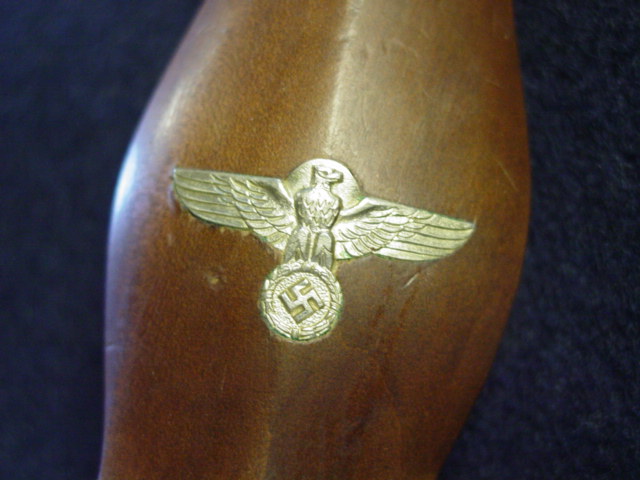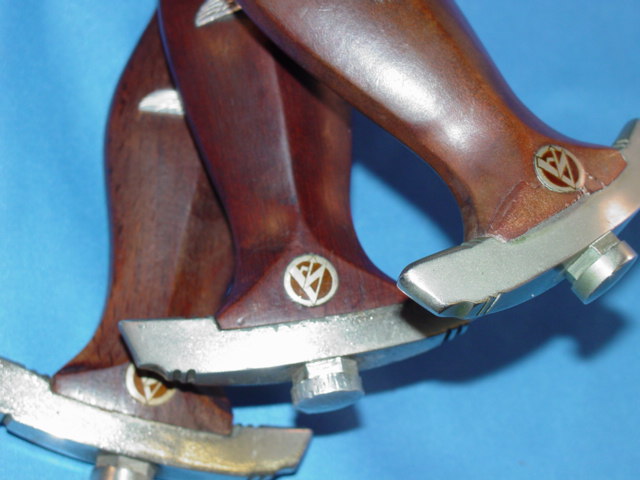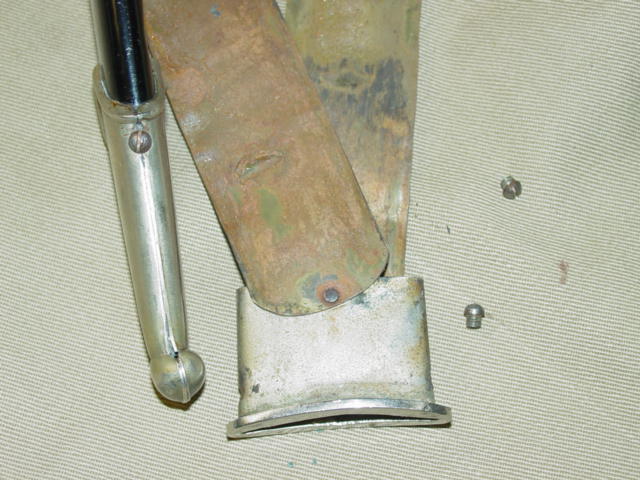THE HISTORY OF THE SA DAGGER

DAGGER CONSTRUCTION MATERIALS
one of the characteristics that makes The SA dagger a desirable collector is its elegant appearance. The handle
is sleek and simple but very elegant. The earth toned colors are nicely complemented by the silver metal
accessories. The SA round symbol match very nicely the wooden handle in which it is embeded.
 Enlarge image (+)
Enlarge image (+)
|
The handle of the dagger was manufactured of beech, cherry, fruitwood, plumbwood and oak (Some of the light
colored SA dagger handles were produced from this material).
The metal accessories (pommel, handguard, eagle, scabbard throat and tip) are made of nickel silver or zinc.
Nickel silver is a metal alloy of copper with nickel and often but not always zinc. It is named for its
silvery appearance, but contains no elemental silver unless plated. Other common names for this alloy are
German silver, paktong, new silver and alpacca (or alpaca).
|
The color of the scabbards can be applied either anodized or painted. Anodizing, or anodising, is an
electrolytic passivation process used to increase the thickness of the natural oxide layer on the surface of
metal parts. Anodizing increases corrosion resistance and wear resistance, and provides better adhesion for
paint primers and glues than bare metal.
A couple of interesting things to note is that the NSKK (transportation) dagger was identical to the SA dagger
except that the scabbard was of black color. The SS dagger also shared the same appearance as the SA dagger
but it was all black, had a different eagle and had an SS round insignia replace the SA round insignia in the
upper portion of the handle.
|
 Enlarge image (+)
Enlarge image (+)
|
THE ANATOMY OF THE SA DAGGER
The SA daggers are put together by using a combination of small screws and a top nut in the pommel area. The
screws secure the scabbard components. The nut screws into the top of the blade and maintains the handle and
cross guards in place.
It is recommended that a special tool be used to take off the nut. Otherwise a risk of leaving marks on
the body of the nut is taken. Sometimes the tang of the blade will have manufacturer markings. This is
not always the case.
The picture to the right shows two variations of the material from which the tips are constructed. The
center tip is made of Zinc. The other tips are Nickel-silver.
A weight is added to the inside of the tip area. This extra weight maintains a better position for the
dagger when it is worn.
|
 Enlarge image (+)
Enlarge image (+)
|
 Enlarge image (+)
Enlarge image (+)
|
The item featured in this photo is an NSKK dagger. However, the anatony is identical to an SA dagger.
Two runners are a part of the throat section. The apply pressure to the blade of the dagger keeping it from
falling off during physical activities or simply when the dagger is turned upside-down.
The runners can be bent for creating a better fit. Over time the bend is lost and the blade may loose
its fitting to the scabbard. Attention must be paid not too adjust the runners too much because they
could scratch the blade of the dagger. Some daggers may have blades in such good condition that the
only worn discernable is that created by the runners. Luckily, this damage is reversible most of the
time.
The photo shows the two runners. The screws that secure the throat area are laying on the ground.
|
INTERESTED IN BUYING OR SELLING AN SA DAGGER?
Visit the
"German WWII -> Daggers and Parts"
section of our store to see the available inventory. All items there have a money-back guarantee to be original,
unless otherwise stated. You can buy from us with confidence.
Fell free to contact us. We will make you an offer for a single item or an entire collection.
Page 3
Continued - The history of the SA dagger

While the item featured here is not for sale, similar items like it are available for
purchase in our website MilitaryItems.com
|





